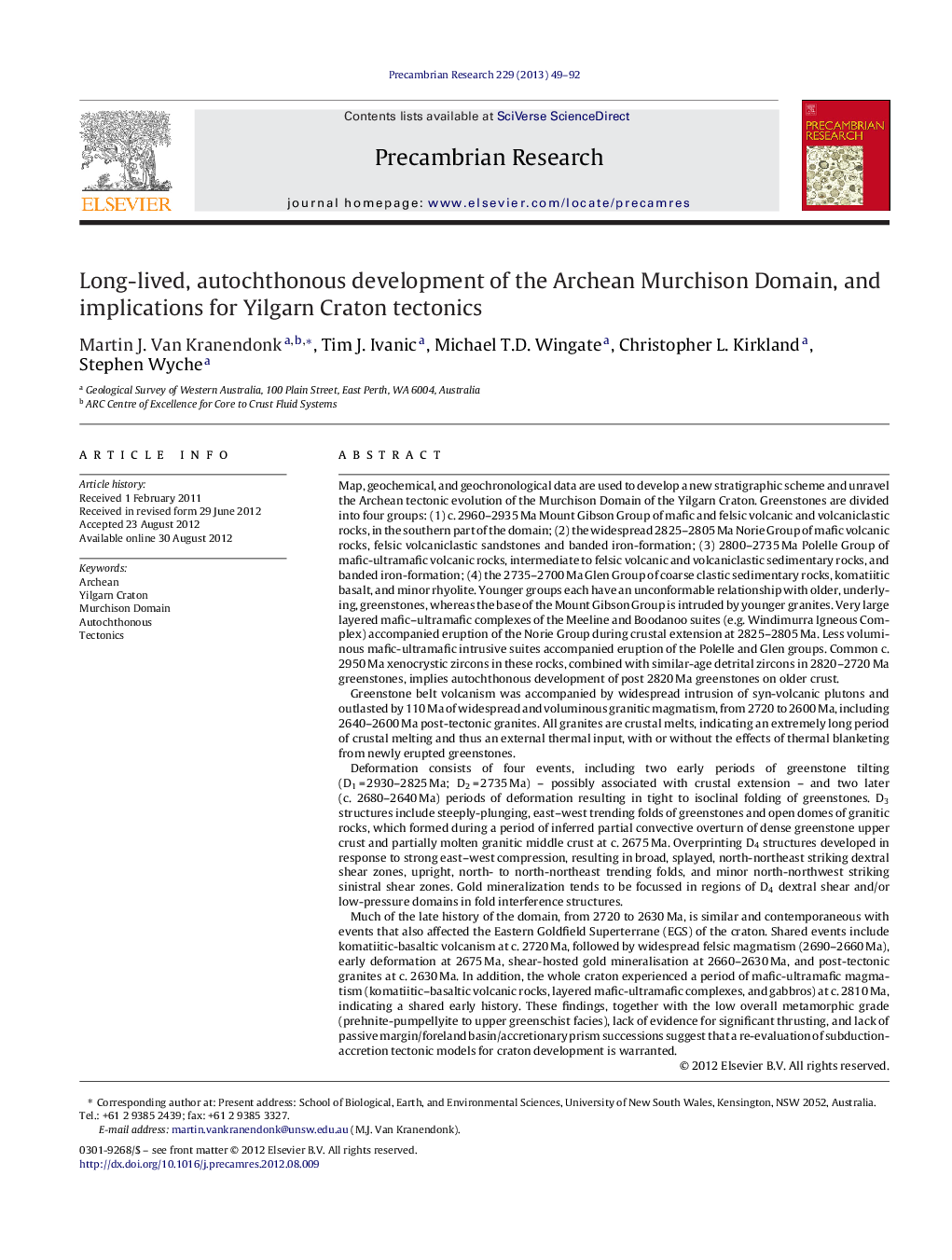| Article ID | Journal | Published Year | Pages | File Type |
|---|---|---|---|---|
| 4723299 | Precambrian Research | 2013 | 44 Pages |
Map, geochemical, and geochronological data are used to develop a new stratigraphic scheme and unravel the Archean tectonic evolution of the Murchison Domain of the Yilgarn Craton. Greenstones are divided into four groups: (1) c. 2960–2935 Ma Mount Gibson Group of mafic and felsic volcanic and volcaniclastic rocks, in the southern part of the domain; (2) the widespread 2825–2805 Ma Norie Group of mafic volcanic rocks, felsic volcaniclastic sandstones and banded iron-formation; (3) 2800–2735 Ma Polelle Group of mafic-ultramafic volcanic rocks, intermediate to felsic volcanic and volcaniclastic sedimentary rocks, and banded iron-formation; (4) the 2735–2700 Ma Glen Group of coarse clastic sedimentary rocks, komatiitic basalt, and minor rhyolite. Younger groups each have an unconformable relationship with older, underlying, greenstones, whereas the base of the Mount Gibson Group is intruded by younger granites. Very large layered mafic–ultramafic complexes of the Meeline and Boodanoo suites (e.g. Windimurra Igneous Complex) accompanied eruption of the Norie Group during crustal extension at 2825–2805 Ma. Less voluminous mafic-ultramafic intrusive suites accompanied eruption of the Polelle and Glen groups. Common c. 2950 Ma xenocrystic zircons in these rocks, combined with similar-age detrital zircons in 2820–2720 Ma greenstones, implies autochthonous development of post 2820 Ma greenstones on older crust.Greenstone belt volcanism was accompanied by widespread intrusion of syn-volcanic plutons and outlasted by 110 Ma of widespread and voluminous granitic magmatism, from 2720 to 2600 Ma, including 2640–2600 Ma post-tectonic granites. All granites are crustal melts, indicating an extremely long period of crustal melting and thus an external thermal input, with or without the effects of thermal blanketing from newly erupted greenstones.Deformation consists of four events, including two early periods of greenstone tilting (D1 = 2930–2825 Ma; D2 = 2735 Ma) – possibly associated with crustal extension – and two later (c. 2680–2640 Ma) periods of deformation resulting in tight to isoclinal folding of greenstones. D3 structures include steeply-plunging, east–west trending folds of greenstones and open domes of granitic rocks, which formed during a period of inferred partial convective overturn of dense greenstone upper crust and partially molten granitic middle crust at c. 2675 Ma. Overprinting D4 structures developed in response to strong east–west compression, resulting in broad, splayed, north-northeast striking dextral shear zones, upright, north- to north-northeast trending folds, and minor north-northwest striking sinistral shear zones. Gold mineralization tends to be focussed in regions of D4 dextral shear and/or low-pressure domains in fold interference structures.Much of the late history of the domain, from 2720 to 2630 Ma, is similar and contemporaneous with events that also affected the Eastern Goldfield Superterrane (EGS) of the craton. Shared events include komatiitic-basaltic volcanism at c. 2720 Ma, followed by widespread felsic magmatism (2690–2660 Ma), early deformation at 2675 Ma, shear-hosted gold mineralisation at 2660–2630 Ma, and post-tectonic granites at c. 2630 Ma. In addition, the whole craton experienced a period of mafic-ultramafic magmatism (komatiitic–basaltic volcanic rocks, layered mafic-ultramafic complexes, and gabbros) at c. 2810 Ma, indicating a shared early history. These findings, together with the low overall metamorphic grade (prehnite-pumpellyite to upper greenschist facies), lack of evidence for significant thrusting, and lack of passive margin/foreland basin/accretionary prism successions suggest that a re-evaluation of subduction-accretion tectonic models for craton development is warranted.
► Presents extensive geological data for the Archean Murchison Domain, Yilgarn Craton. ► Outcrop and zircon data indicate autochthonous crustal development from 2.95 to 2.6 Ga. ► Geochemistry of (ultra)mafic rocks indicate a long-lived, evolving plume source. ► Common history with adjacent crust is at odds with arc-accretion tectonic models.
